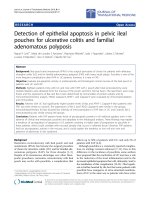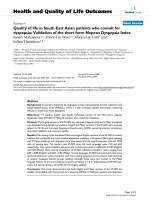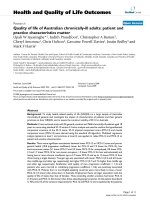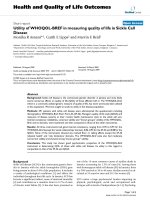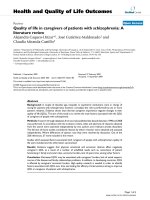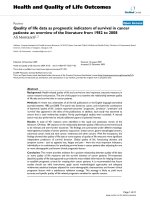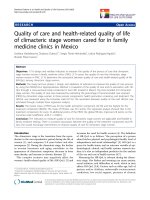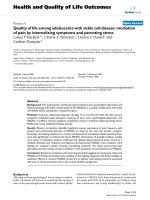báo cáo hóa học:" Quality of life and the impact of drug toxicities in a South African community-based antiretroviral programme" docx
Bạn đang xem bản rút gọn của tài liệu. Xem và tải ngay bản đầy đủ của tài liệu tại đây (354.59 KB, 13 trang )
BioMed Central
Page 1 of 13
(page number not for citation purposes)
Journal of the International AIDS
Society
Open Access
Research
Quality of life and the impact of drug toxicities in a South African
community-based antiretroviral programme
Jennifer Pitt*
1
, Landon Myer
2,3
and Robin Wood
1
Address:
1
Desmond Tutu HIV Foundation, Institute of Infectious Diseases and Molecular Medicine, Cape Town, South Africa,
2
Infectious Diseases
Epidemiology Unit, School of Public Health & Family Medicine, University of Cape Town, Cape Town, South Africa and
3
Department of
Epidemiology, Mailman School of Public Health, Columbia University, New York, NY, USA
Email: Jennifer Pitt* - ; Landon Myer - ; Robin Wood - robin.wood@hiv-
research.org.za
* Corresponding author
Abstract
Background: The impact of highly active antiretroviral therapy (HAART) on health-related quality of life has
been widely researched in the developed world, but there are few data from sub-Saharan Africa, where the vast
majority of HIV-infected individuals live. This study examined health-related quality of life among HIV-positive
individuals initiating HAART in Cape Town, South Africa, and explored the impact of HAART-related drug
toxicities on quality of life.
Methods: Health-related quality of life was assessed using a standardised questionnaire, the Medical Outcomes
Survey Short Form 36. Physical health summary scores and mental health summary scores were compared pre-
HAART and at regular intervals during the first 48 weeks of HAART. The relationships between socio-
demographic, baseline and on-treatment variables and decline in health-related quality of life, as well as the impact
of drug toxicities on quality of life, were assessed in unadjusted bivariate and adjusted multivariate analyses.
Results: Two hundred and ninety-five patients were enrolled into the study. There was a significant increase in
health-related quality of life during the first 48 weeks on HAART. The median physical health summary score
increased from 45 to 53 units (p < 0.001) and median mental health summary score increased from 45 to 50 units
(p < 0.001).
The bulk of this increase occurred during the first 16 weeks. Overall, 23% of participants experienced a decline
in their physical health summary score, while 34% showed a decline in the mental health summary score. Average
drops in median physical and mental health summary scores were 8.4 units (SD 9.31) and 9.9 (SD 11.4) units
respectively. Participants with drug toxicity had lower physical health summary scores than participants without
drug toxicity at all time points. However, only three participants with toxicity (27%) reported an actual decline in
health-related quality of life by week 48. Drug toxicities had little impact on mental health summary scores.
Conclusion: These results confirm the health-related quality of life benefits of HAART. While the majority of
patients experienced a significant improvement in health-related quality of life on HAART, up to a third of patients
reported declines in this quality of life. This was largely related to better baseline clinical state. HAART-related
drug toxicities did not have a significant impact on health-related quality of life during the first year of HAART,
which supports the ongoing use of the current national first-line regimen.
Published: 24 April 2009
Journal of the International AIDS Society 2009, 12:5 doi:10.1186/1758-2652-12-5
Received: 3 November 2008
Accepted: 24 April 2009
This article is available from: />© 2009 Pitt et al; licensee BioMed Central Ltd.
This is an Open Access article distributed under the terms of the Creative Commons Attribution License ( />),
which permits unrestricted use, distribution, and reproduction in any medium, provided the original work is properly cited.
Journal of the International AIDS Society 2009, 12:5 />Page 2 of 13
(page number not for citation purposes)
Background
By December 2006, an estimated 39.5 million people
worldwide were living with HIV and a further 2.9 million
people had died due to AIDS. The bulk of infections (63%
of the global burden) occurred in sub-Saharan Africa,
where 24.7 million people were reported to be HIV
infected [1]. In South Africa alone, 5.4 million people
were estimated to be infected with HIV by the middle of
2006 and 600 000 were thought to have AIDS [2].
Prior to 2004, people infected with HIV in South Africa
who were unable to access life-saving antiretroviral (ARV)
therapy progressed to AIDS and died of their disease. The
rollout of highly active antiretroviral therapy (HAART)
through national and provincial programmes has dramat-
ically altered this experience.
By late 2008, an estimated 549 700 HIV-positive individ-
uals were receiving HAART in South Africa [3]. With
increasing numbers of HIV-positive individuals being
enrolled onto HAART and increasing survival among
these patients, there is a growing need to understand the
impact of HAART use on the quality of lives of HIV-
infected individuals [4-8].
There is a sizeable body of research on the impact of
HAART on health-related quality of life (HRQoL) in the
developed world. Most recent cohort studies in the USA
and Europe have shown no significant change in HRQoL
within the first two years of HAART [9-11], although one
study showed an increase in mental quality of life only
[12], and two showed a decrease in physical quality of life
[13,14].
Table 1: Demographic, baseline and on-treatment characteristics of female and male patients with any health-related quality of life
data
Variable Total Female Male P-value
Number 295 219 76 -
Age (years) (mean, (SD) 34 (7) 33 (7) 38 (6) <0.001
WHO stage 3 & 4
(n,(%))
254 (86) 184 (86) 70 (92) 0.079
Baseline CD4 count cells/mm
3
(median, (IQR))
88
(47; 148)
96
(52; 159)
77
(36; 130)
0.027
Baseline viral load
copies/ml
(median, (IQR))
80,876
(33,194; 201,784)
76,452
(31,547; 198,193)
87,763
(42,884; 211,938)
0.216
Baseline viral load
log copies/ml
(median, (IQR))
4.88
(4.52; 5.30)
4.88
(4.50; 5.30)
4.94
(4.63; 5.32)
0.216
Week 48 CD4 count cells/mm
3
(median, (IQR))
261
(183; 340)
265
(205; 365)
215
(171; 304)
0.004
Week 48 viral load
copies/ml
(median,(IQR))
49
(49; 49)
49
(49; 49)
49
(49; 49)
0.340
Week 48 viral load
log copies/ml
(median,(IQR))
1.69
(1.69; 1.69)
1.69
(1.69; 1.69)
1.69
(1.69; 1.69)
0.276
Change in CD4 count cells/mm
3
(mean, (SD))
178 (130) 184 (136) 159 (107) 0.152
Change in viral load
log copies/ml
(mean, (SD))
-2.96 (0.91) -2.91 (0.95) -3.11 (0.75) 0.107
Drug toxicity
(n, (%))
11 (4%) 10 (5%) 1 (1%) 0.198
Journal of the International AIDS Society 2009, 12:5 />Page 3 of 13
(page number not for citation purposes)
In contrast, the 2NN study, which compared the efficacy
and safety of three non-nucleoside reverse transcriptase
inhibitor (NNRTI)-containing regimens (nevirapine, efa-
virenz, and nevirapine plus efavirenz in combination with
stavudine and lamivudine) showed an overall improve-
ment in HRQoL over 48 weeks [15].
To date, only four studies have addressed the impact of
HAART on HRQoL in developing countries [16-19].
Wouters et al [16] and Louwagie et al [17] assessed the
impact of HAART on HRQoL in cross-sectional surveys,
and showed a significant association between HAART and
improved physical and emotional health. Unfortunately,
the cross-sectional nature of these two studies and the lim-
ited time that participants were on HAART (six months or
less) restrict the inferences that can be drawn from these
studies.
Only the studies by Stangl et al [18] and Jelsma et al [19]
assessed longitudinal changes in HRQoL associated with
HAART use. Both reported a significant improvement in
HRQoL over 12 months of HAART, with the bulk of this
improvement occurring within the first three months on
treatment.
Internationally, there is concern about the impact of
HAART-related toxicity on HRQoL. In fact, it has been
suggested that studies that consider only mortality out-
comes ignore treatment-related morbidity and may actu-
ally overestimate the benefits of HAART [20].
These international concerns are echoed in South Africa
and other developing countries, where national first-line
regimens tend to be NNRTI-based and incorporate drugs
such as stavudine, which has been shown to be the reason
for up to 75% of drug switches for toxicity within the first
three years of first-line HAART [21]. In South Africa, there
is an ongoing debate about whether or not the side-effect
profile of HAART may adversely affect the HRQoL of HIV-
positive individuals.
More data about the impact of HAART and HAART-
related toxicities on HRQoL are required in developing
countries to inform programme and policy decisions
about HAART roll-out strategies in order to maximise the
quality of life of HIV-infected individuals.
Methods
Study population
This cohort study examined the HRQoL reported by HIV-
positive individuals pre-HAART and at regular intervals
during their first year of receiving HAART at the Hannan
Crusaid Treatment Centre between September 2002 and
March 2005. As per the national ARV guidelines, adult
patients who had World Health Organization (WHO)
Stage 4 disease and/or a CD4+ T cell count of <200 cells/
mm
3
were commenced on first-line ARVs [22]. The major-
ity of patients (99.6%) initiated on-treatment were ARV-
naïve.
The Hannan Crusaid Treatment Centre is a community-
based ARV clinic that was initiated in September 2002 as
a joint venture between the Western Cape Department of
Health, Desmond Tutu HIV Foundation and Crusaid, a
UK-based non-governmental organization that raises
funds to support people living with HIV/AIDS. The clinic
was one of the first ARV rollout sites in the Western Cape
Province of South Africa. It is situated alongside the pri-
mary community health care centre and boasts a multidis-
ciplinary team of medical doctors, clinical nurse
practitioners, clinic nurses, Sizophila adherence counsel-
lors and a pharmacist.
Table 2: Median scores for the eight health concepts pre-HAART and at week 16, 32 and 48 on HAART (n = 147)
Pre-HAART Week 16 Week 32 Week 48
Physical function 85 95 100 100
Physical role 50 100 100 100
Bodily pain 61 84 74 84
General health 54 77 77 72
Vitality 55 75 80 85
Social function 75 100 100 100
Emotional role 50 99 99 99
Mental health 68 72 76 72
Journal of the International AIDS Society 2009, 12:5 />Page 4 of 13
(page number not for citation purposes)
The clinic followed a programmatic approach to ARV care
with a standard first-line and second-line regimen. In
keeping with WHO recommendations, the first-line regi-
men was NNRTI-based and the second was protease
inhibitor-based [23].
Adults commenced on the first-line regimen (efavirenz or
nevirapine plus stavudine and lamivudine) were reviewed
at four, eight and 16 weeks, and thereafter every four
months by a medical doctor. At these scheduled visits,
patients were assessed clinically, virologically and immu-
nologically. Patients who discontinued their first-line reg-
imen – either due to virological failure or for toxicity
reasons – were worked up for the second-line regimen
(lopinavir/ritonavir, didanosine and zidovudine). Nucle-
oside reverse transcriptase inhibitor (NRTI) substitutions
were made within regimen 1 or 2 for NRTI-associated tox-
icities.
Study procedures
At the screening visit, HIV-positive individuals met with
the clinic nurse, who completed a demographic informa-
tion sheet. Blood was drawn for viral load, CD4 cell count
and safety blood testing (including a full blood count and
liver function tests) at the screening visit and at all subse-
quent scheduled visits prior to the patient seeing the med-
ical doctor.
The adherence counsellors were trained in the administra-
tion of the HRQoL instrument. The quality of life question-
naire was administered at each of the following scheduled
visits: screening, baseline, week 16, week 32, week 48 and
week 64. Although HRQoL data continued to be collected
at scheduled visits following week 64, this study focused on
quality of life only during the first year of ARVs.
HRQoL data were intended to be collected on all patients
at all scheduled visits within the first year. This, however,
was not always possible. Reasons for incomplete HRQoL
data were: death, loss to follow up, transfer out, and
patients leaving the clinic without the questionnaire being
administered. The analysis only included those patients
with HRQoL data available at all time points during the
first year on HAART.
The University of Cape Town Research Ethics Committee
approved all research activities involving antiretroviral
service delivery and patient outcomes at the site. Patients
signed a research consent form at the screening visit, indi-
cating their willingness to take part in this research study.
Study measures
Quality of life
Health-related quality of life was assessed using a stand-
ardised questionnaire, the Medical Outcomes Survey
Short Form 36 (MOS-SF36). The instrument uses 36 items
to assess eight health concepts: (1) physical functioning;
(2) role limitations because of physical health problems;
(3) bodily pain; (4) social functioning; (5) general mental
health; (6) role limitations because of emotional prob-
lems; (7) vitality; and (8) general health perceptions [24].
The MOS-SF36 questionnaire has been widely used in
studies of quality of life in HIV-positive patients in both
developed and developing countries, and has performed
well in all of these settings [11,12,14,25-28]. The instru-
ment has also undergone validity and reliability testing in
a multiracial South African population and was able to
differentiate between HIV-infected and non-infected indi-
viduals [28]. Population values exist for several countries,
Change in median physical health summary score and median mental health summary score over the first 48 weeks of HAARTFigure 1
Change in median physical health summary score
and median mental health summary score over the
first 48 weeks of HAART.
0 20 40 60 80
Median PHS score over 48 weeks
pre HAART Week 16
Week 32 Week 48
20 30 40 50 60 70
Median MHS score over 48 weeks
pre HAART Week 16
Week 32 Week 48
Journal of the International AIDS Society 2009, 12:5 />Page 5 of 13
(page number not for citation purposes)
including South Africa. The English version of the instru-
ment was used, with standard Xhosa explanations given
by the counsellors for difficult concepts.
Quality of life data were entered using a custom-designed Epi
Info™ template to ensure high data quality. On completion
of data entry for each questionnaire, scores for the eight
health components were automatically generated according
to standard scoring algorithms. Data were then transferred
into a Microsoft Excel spreadsheet where health component
scores were transformed into the physical health summary
(PHS) and mental health summary (MHS) scores using
standardised factor analysis-based weights.
Missing questionnaire items were estimated using a standard
scoring algorithm that estimates missing values [24]. Scores
for screening and baseline were combined to form an aver-
age pre-HAART score. For those participants whose week 48
scores were not available, week 64 scores were used to
replace missing data. This replacement of scores was deemed
acceptable as data analysis demonstrated no significant dif-
ference between overall week 48 and week 64 scores.
Socio-demographic and clinical information
Demographic information was collected using standard
paperwork. Patients were staged according to WHO clini-
cal criteria by the medical doctor at their screening visit.
The Toga Laboratory performed viral load and CD4 cell
count testing. Viral load testing made use of the branch
DNA hybridisation technique (Versant™ HIV-1 RNA 3.0
branched chain DNA assay, Bayer HealthCare,
Leverkusen, Germany) and CD4+ T cell counts were meas-
ured by flow cytometry (FACSCount™, Becton Dickinson,
Franklin Lakes, NJ, USA).
Change in physical health summary score and mental health summary score over the first 48 weeks of HAART for 15 random participantsFigure 2
Change in physical health summary score and mental health summary score over the first 48 weeks of HAART
for 15 random participants.
Journal of the International AIDS Society 2009, 12:5 />Page 6 of 13
(page number not for citation purposes)
Table 3: Factors associated with negative physical health summary score at week 48
Variable Univariate model Multivariate model 1 Multivariate model 2
Odds ratio, 95% CI
(P-value)
Odds ratio, 95% CI
(P-value)
Odds ratio, 95% CI
(P-value)
Age (continuous) 1.04, (0.98; 1.09)
0.184
1.08, (1.01; 1.15)
0.034
1.07 (1.01; 1.14)
0.029
Age
(≤ 34 = 0, >34 = 1)
1.20, (0.56; 2.60)
0.637
Gender
(male = 0, female = 1)
0.55, (0.19; 1.56)
0.260
0.52, (0.14; 1.99)
0.341
WHO stage
(1&2 = 0, 3&4 = 1)
0.38, (0.13; 1.08)
0.068
0.61, (0.17; 2.15)
0.441
Baseline CD4 count cells/mm
3
(>50 = 0, ≤ 50 = 1)
0.42, (0.15; 1.17)
0.098
0.93, (0.25; 3.41)
0.910
Baseline viral load log copies/ml
(≤ 5 = 0, >5 = 1)
0.24, (0.10; 0.59)
0.002
0.48, (0.14; 1.65)
0.245
0.22, (0.08; 0.60)
0.003
Pre-HAART PHS score
(continuous)
1.14 (1.07; 1.21)
<0.001
1.16 (1.08; 1.24)
<0.001
1.15 (1.08; 1.23)
<0.001
Week 48 CD4 count cells/mm
3
(<250 = 0, ≥ 250 = 1)
0.63, (0.29; 1.37)
0.245
Week 48 CD4 count cells/mm
3
<200 1
200–350 0.62, (0.25; 1.51)
0.29
350–500 0.67, (0.22; 2.07)
0.483
≥ 500 0.42, (0.08; 2.21)
0.309
Week 48 viral load copies/ml
(<50 = 0, ≥ 50 = 1)
0.96, (0.37; 2.48)
0.935
Week 48 viral load copies/ml <50 1
50–399 0.39, (0.08; 1.79)
0.224
400–4999 1.10, (0.11; 11.00)
0.936
≥ 5000 3.30, (0.77; 14.07)
0.107
Week 48 log viral load
log copies/ml
(<1.69 = 0, ≥ 1.69 = 1)
0.96, (0.37; 2.48)
0.935
Journal of the International AIDS Society 2009, 12:5 />Page 7 of 13
(page number not for citation purposes)
Drug toxicities were detected by the medical doctor at
both scheduled and unscheduled clinical visits through
clinical questioning, examination and safety blood draws
(including a full blood count, liver function tests, amylase
and lactate levels as requested). Drug toxicities were
defined as any adverse event thought by the clinician to be
HAART-related and that required a change in antiretrovi-
ral therapy. Drug changes could either be a NRTI substitu-
tion or a change from NNRTI to a protease inhibitor.
Statistical analysis
The cohort was initially described using means, medians
and proportions, as appropriate. Changes in HRQoL pre-
HAART and at week 16, 32 and 48 were compared using
the Wilcoxon Rank Sum Test. Crude associations were first
examined using Fisher's Exact, Chi Squared and Wilcoxon
Rank Sum tests, as appropriate.
Negative HRQoL was defined as a decrease in PHS or MHS
scores between pre-HAART and week 48. Univariate rela-
tionships were then explored between the outcome varia-
bles – negative PHS and negative MHS – and each
explanatory variable. Multivariate analyses made use of
logistic regression models to examine the adjusted associ-
ation between negative HRQoL and various socio-demo-
graphic, baseline and on-treatment explanatory variables
as appropriate.
Multivariate analysis started with a full model (Model 1)
and explanatory variables were removed in a stepwise
manner until the final model (Model 2) was selected. All
final logistic regression models were checked against
model assumptions. Outliers and potentially influential
observations were identified and examined to ensure that
model results were not being unduly influenced by a
small number of non-representative observations. Models
were rerun with selected observations excluded.
All statistical analyses were performed using Intercooled
Stata Version 8.2 (Stata Corporation, College Station,
Texas, USA). All statistical tests are two-sided at alpha =
0.05.
Results
Of the 295 patients with any HRQoL data, 292 (99%) had
baseline data, 271 (92%) had week 16 data, 233 (79%)
had week 32 data, and 179 (61%) had week 48 data.
Complete HRQoL data, obtained pre-treatment and at
every scheduled on-treatment visit, were available for 147
patients.
Demographic, baseline and on-treatment characteristic
Table 1 describes the demographic and baseline character-
istics of the 295 patients with any HRQoL data. The aver-
age age of the cohort was 34 years (standard deviation: 4)
and 74% of patients were female (n = 219). Eighty-six per-
cent of patients (n = 370) had WHO Stage 3 and 4 disease.
The median baseline CD4 count was 88 cells/mm
3
(inter
quartile range: 44, 154) and median baseline log viral
load was 4.9 (inter quartile range: 4.5, 5.3). Men were
older and had more advanced disease than women. The
majority of drug toxicities (90.9%) occurred in women
with only one drug change made due to toxicity among
men. There were no differences in demographic and base-
line characteristics between patients with complete
HRQoL data (n = 147) and those with incomplete data (n
= 148).
Health-related quality of life data
The median scores for the eight health concepts pre-treat-
ment and at regular intervals on-treatment are described
in Table 2. The scores all demonstrated an increase in
HRQoL between pre-HAART and week 48, with the great-
est increase occurring at week 16 (p < 0.001).
Week 48 log viral load
log copies/ml
<1.69 1
1.69–2.59 0.58, (0.16; 2.14)
0.414
2.60–3.69 1.10, (0.11; 11.00)
0.936
≥ 3.69 2.47, (0.51; 11.74)
0.225
Δ CD4 count cells/mm
3
0.995, (0.991; 0.999)
0.010
0.998, (0.993; 1.003)
0.420
Δ log viral load log copies/ml 0.58, (0.37; 0.90)
0.015
0.66, (0.36; 1.27)
0.209
Table 3: Factors associated with negative physical health summary score at week 48 (Continued)
Journal of the International AIDS Society 2009, 12:5 />Page 8 of 13
(page number not for citation purposes)
Table 4: Factors associated with negative mental health summary score at week 48
Variable Univariate model Multivariate
model 1
Multivariate
model 2
Odds ratio, 95% CI
(P-value)
Odds ratio, 95% CI
(P-value)
Odds ratio, 95% CI
(P-value)
Age (continuous) 1.01, (0.96; 1.06)
0.767
Age
(<34 = 0, >34 = 1)
1.49, (0.75; 2.96)
0.258
2.20, (0.94; 5.15)
0.068
1.77, (0.83; 3.78)
0.142
Gender
(male = 0, female = 1)
0.58, (0.24; 1.41)
0.227
0.65, (0.23; 1.85)
0.419
WHO stage
(1&2 = 0, 3&4 = 1)
0.94, (0.33; 2.71)
0.906
1.45, (0.44; 4.83)
0.543
Baseline CD4 count cells/mm
3
(>50 = 0, <50 = 1)
0.35, (0.14; 0.86)
0.022
0.38, (0.14; 1.07)
0.067
0.41, (0.16; 1.09)
0.075
Baseline viral load
log copies/ml (<5 = 0, >5 = 1)
0.41, (0.20; 0.83)
0.014
0.55, (0.20; 1.49)
0.239
0.50, (0.23; 1.09)
0.081
Pre-HAART MHS score
(continuous)
1.10 (1.05; 1.16)
<0.001
1.10 (1.04; 1.16)
<0.001
1.09 (1.04; 1.15)
0.001
Week 48 CD4 count cells/mm
3
(<250 = 0, >250 = 1)
1.67, (0.83; 3.37)
0.151
Week 48 CD4 count cells/mm
3
<200 1
200–350 5.18, (1.92; 13.96)
0.001
350–500 2.39, (0.72; 7.91)
0.155
>500 2.52, (0.58; 10.88)
0.216
Week 48 viral load copies/ml
(<50 = 0, >50 = 1)
1.30, (0.57; 2.94)
0.535
Week 48 viral load copies/ml <50 1
50–399 0.95, (0.33; 2.69)
0.919
400–4999 2.05, (0.28; 15.14)
0.481
>5000 2.05, (0.49; 8.66)
0.327
Week 48 viral load
log copies/ml
(<1.69 = 0, >1.69 = 1)
1.30, (0.57; 2.94)
0.535
Journal of the International AIDS Society 2009, 12:5 />Page 9 of 13
(page number not for citation purposes)
The physical health summary and mental health sum-
mary scores also showed an improvement in HRQoL over
time (Figure 1). There was a significant increase in both
summary scores between pre-HAART and week 16. The
median PHS score increased from 45 to 53 units (p <
0.001) and the median MHS score increased from 45 to
51 units (p < 0.001). These increases were then main-
tained through weeks 32 and 48.
However, not all participants experienced a linear increase
in HRQoL. Using a random sample of 15 participants, it
was evident that while the bulk of participants experi-
enced a gradual improvement in HRQoL, others experi-
enced a worsening of HRQoL (Figure 2). While the
average change in PHS score between pre-HAART and
week 48 was an increase of seven units (standard devia-
tion: 11.9), 23% of participants experienced a decrease in
PHS score during this period. The average drop in PHS
score among these participants was 8.4 units (standard
deviation: 9.31).
Similarly, while MHS score increased by an average of 3.3
units (standard deviation: 11.4) between pre-HAART and
week 48, 34% of participants experienced a decline in
MHS score. The average drop in MHS score among these
participants was 9.9 units (standard deviation: 5.92).
Factors associated with negative change in quality of life
Baseline log viral load, pre-HAART PHS score, change in
CD4 count and change in log viral load were all strongly
associated with a negative PHS in the univariate analyses
(Table 3).
In the multivariate regression model, pre-HAART PHS
score and baseline log viral load were the strongest predic-
tors of negative PHS at week 48. Participants with a higher
pre-HAART HRQoL score were more likely to report neg-
ative PHS (OR1.15; 95% CI 1.08, 1.23; p < 0.001),
whereas participants with a higher baseline log viral load
(>5.0 log) were less likely to report negative PHS than par-
ticipants with a lower baseline log viral load (≤ 5.0 log)
(OR 0.22; 95% CI 0.08, 0.60; p = 0.003).
Age was also predictive of negative PHS. Older partici-
pants (above 34 years of age) were more likely to report
negative PHS than younger participants (OR 1.07; 95% CI
1.01, 1.14, 0.085; p = 0.029). Neither gender nor any of
the week 48 variables were associated with negative PHS.
Baseline CD4 count, baseline log viral load, pre-HAART
MHS score and change in log viral load were all associated
with negative MHS in the univariate models (Table 4). In
the multivariate regression model, pre-HAART MHS score
was the strongest predictor of negative MHS at 48 weeks.
Participants with higher pre-HAART HRQoL scores were
more likely to report negative MHS than participants with
lower pre-HAART MHS scores (OR 1.09; 95% CI 1.04,
1.15; p = 0.001).
Baseline CD4 count and baseline log viral load remained
weakly associated with the outcome. Participants with
lower baseline CD4 count (≤ 50 cells/mm
3
) were less
likely to experience negative MHS than participants with
higher baseline CD4 count (>50 cells/mm
3
) (OR 0.41;
95% CI 0.16, 1.09; p = 0.075). Participants with a higher
baseline log viral load (>5.0 log) were less likely to expe-
rience negative MHS than participants with lower baseline
log viral load (≤ 5.0 log) (OR 0.50; 95% CI 0.23, 1.09; p
= 0.081). Gender and the week 48 variables were not pre-
dictive of negative MHS at 48 weeks.
Drug toxicities and quality of life
Eleven participants experienced drug-related toxicities
during the first 48 weeks of HAART. Ninety-one percent
(n = 10) of these toxicities occurred in women, with 50%
(n = 5) of these being due to lactic acidosis. Participants
experiencing drug toxicities had similar demographic and
baseline characteristics to the overall cohort.
Week 48 viral load
log copies/ml
<1.69 1
1.69–2.59 0.88, (0.31; 2.47)
0.808
2.60–3.69 2.05, (0.28; 15.14)
0.481
>3.69 2.74, (0.58; 12.85)
0.202
Δ CD4 count cells/mm
3
0.999, (0.996; 1.002)
0.414
1.002, (0.998; 1.01)
0.389
Δ log viral load log copies/ml 0.67, (0.44; 1.01)
0.054
0.74, (0.43; 1.28)
0.282
Table 4: Factors associated with negative mental health summary score at week 48 (Continued)
Journal of the International AIDS Society 2009, 12:5 />Page 10 of 13
(page number not for citation purposes)
Table 5 describes the types of drug toxicities that occurred
during the first year of HAART. Efavirenz hypersensitivity
reactions were the cause of drug toxicities within the first
16 weeks of HAART. Between weeks 16 and 32, peripheral
neuropathies were the main reason for drug changes. Ele-
vated transaminases and hyperlactatemia were the main
causes of drug toxicities between weeks 32 and 48 of
HAART.
One patient experienced an efavirenz hypersensitivity
reaction between weeks 32 and 48. This was due to the
fact that the patient was switched to efavirenz at this time.
The bulk (64%) of toxicities occurred during the week 32
to 48 interval and were mostly elevated transaminases and
hyperlactataemia related to stavudine use.
The 11 participants who experienced drug toxicity during
the first 48 weeks of HAART achieved lower PHS scores at
all time points than the 281 participants who did not have
toxicity. While these differences were not statistically sig-
nificant pre-HAART and at weeks 16 and 32, they did
become significant at week 48. The median PHS score at
week 48 was 50 for participants with drug toxicity, com-
pared to 53 for participants without drug toxicity (p =
0.0053) (Table 6).
Drug toxicities did not appear to have a significant impact
on median MHS scores over the first 48 weeks of HAART.
The 11 participants with drug toxicity had a lower median
MHS score pre-HAART than the 281 participants without
drug toxicity, but this difference was not statistically sig-
nificant (42 versus 45, p = 0.1793). There was no impact
of baseline mental health status on the reporting of toxic-
ities. At weeks 16, 32 and 48, participants with drug toxic-
ity reported higher median MHS scores than those
without toxicity. Again, these differences were not statisti-
cally significant (Table 6).
Examining the associations between drug toxicity and
negative HRQoL, it was noted that only three (27%) of all
drug toxicities occurred among participants who reported
negative PHS and that these toxicities occurred during the
week 32 to 48 treatment interval. No drug toxicities
occurred among participants who reported negative MHS.
Discussion
This study reported a significant increase in HRQoL dur-
ing the first 48 weeks on HAART, with the bulk of this
increase occurring during the first 16 weeks on treatment.
Improvement in HRQoL occurred across all core domains
assessed, as well as the physical health summary and men-
tal health summary.
This study therefore supports the findings of Stangl et al
[18] and Jelsma et al [19] who both reported an increase
in HRQoL within the first three months of therapy in sim-
ilar patient populations. The dramatic increase in HRQoL
during the first few weeks of HAART occurred over the
time period when patients usually experience the most
significant gains in health. The greatest decrease in viral
load happens within the first few weeks of treatment and
mortality and morbidity rates begin to fall after just a
month on HAART [29,30].
There have been few analyses dealing with declines in PHS
and MHS scores. In fact, negative HRQoL is often over-
shadowed by the overwhelming positive impact of
HAART on HRQoL, and is therefore not reported. This
research showed that although there was a general
improvement in HRQoL on HAART, up to a third of par-
ticipants experienced a decline in HRQoL during the first
48 weeks of HAART. Twenty-three percent of participants
reported a drop in PHS score and 34% reported a drop in
MHS score.
The most significant predictors of negative PHS and MHS
were baseline HRQoL score, baseline log viral load and
baseline CD4 count. The association between higher base-
line HRQoL score and negative HRQoL could have been
due to the fact that patients with higher baseline scores
had less room for improvement and were therefore more
likely to regress to the mean.
Table 5: Description of drug toxicities occurring during the first year of HAART
Description Week 0–16 Week 16–32 Week 32–48 Total
Any toxicity 2 2 7 11
EFV hypersensitivity reaction 2 *** 1 3
Peripheral neuropathy *** 2 *** 2
Elevated transaminases *** *** 1 1
Hyperlactataemia/lactic acidosis *** *** 5 5
Journal of the International AIDS Society 2009, 12:5 />Page 11 of 13
(page number not for citation purposes)
Baseline log viral load was strongly associated with nega-
tive PHS. Participants with higher baseline log viral loads
were less likely to report negative PHS than participants
with lower baseline log viral loads. Similarly, baseline log
viral load and baseline CD4 count were associated with
negative MHS. Participants with higher baseline log viral
loads or lower baseline CD4 counts were less likely to
report negative MHS than participants with lower baseline
log viral loads or higher baseline CD4 counts.
Participants with more advanced disease, characterised by
higher baseline viral loads and lower baseline CD4
counts, were less likely to report a decline in HRQoL than
those with earlier disease. So it was the relatively well
patients entering into the programme who were at greatest
risk of experiencing negative HRQoL. These associations
could be explained by the negative impact of symptoms
on HRQoL [10-12]. Patients with more advanced disease
are more likely to have a greater number or intensity of
symptoms than patients with less advanced disease pre-
HAART [10], but once on HAART, these symptoms
improve [11,12].
Although there is great concern about the impact of drug
toxicities on HRQoL, few studies have directly assessed
this association. In the developed world, symptoms have
been shown to impact negatively on both physical and
mental HRQoL [10,31]. However, the nature of the symp-
toms and whether they were attributed to the disease
process or to HAART was not clear.
In the developing world, Jelsma et al [19] concluded that
possible side effects of HAART had a negligible impact on
HRQoL. This conclusion was based on the overall increase
in HRQoL demonstrated for the cohort and did not spe-
cifically address those patients who experienced a decline
in HRQoL.
Few drug toxicities were recorded during the first 48 weeks
on HAART. While participants who experienced drug tox-
icity had lower PHS scores than participants without a
drug toxicity at all time points (most notably during the
32 to 48 week treatment interval), only three (27%) par-
ticipants with toxicity reported an actual decline in physi-
cal HRQoL between pre-HAART and week 48.
Drug toxicities, especially those related to stavudine use,
may have a negative impact on physical HRQoL at the
time of the toxicity. They do not, however, reduce overall
gains in HRQoL. Drug toxicities had little impact on men-
tal HRQoL.
The greatest strength of this study is its longitudinal
design. This allowed the assessment of the associations
between various socio-demographic and clinical factors
and HRQoL, and allowed for inferences to be made about
causal relationships.
Limitations to the study included possible selection bias
and information bias related to the use of the MOS-SF36
instrument. The loss of up to 50% of patients, who had
incomplete HRQoL data, from the final analysis may have
resulted in a selection bias towards the healthier section of
the cohort. However, as there were no significant differ-
ences in demographic, baseline and on-treatment charac-
teristics between patients with incomplete and complete
Table 6: Median physical health summary and median mental health summary scores and drug toxicity
N Pre-HAART Week 16 Week 32 Week 48
Median PHS
Drug toxicity 11 39 51 52 50
No drug toxicity 281 44 52 53 53
p-value 0.854 0.225 0.390 0.005
Median MHS
Drug toxicity 11 42 51 51 52
No drug toxicity 281 45 50 49 48
p-value 0.179 0.539 0.326 0.912
Median PHS and median MHS pre-HAART and at week 16, 32 and 48 in patients with any drug toxicity at any time in the first year compared to
patients without drug toxicity.
Journal of the International AIDS Society 2009, 12:5 />Page 12 of 13
(page number not for citation purposes)
HRQoL data, it is unlikely that this was the case. This did
impact on the number of patients available for analysis
though, and may have limited the ability of the study to
detect significant associations.
The MOS-SF36 instrument is a generic HRQoL measure
and, like all generic instruments, may not be sensitive
enough to measure the more specific aspects of HRQoL
impacted on by the HIV disease process. This could lead
to either an underestimation or overestimation of HRQoL
scores and, more important, to a change in HRQoL scores,
thereby under-reporting or over-reporting the actual
impact of HAART on HRQoL.
The MOS-SF36 instrument is also prone to ceiling effects,
where substantial numbers of patients get the highest pos-
sible score for a domain. This would have made it difficult
for the instrument to pick up changes in HRQoL at the
upper end of the scale, and may have been a problem with
increasing time on treatment. Ceiling effects could have
lead to the underestimation of HRQoL gains.
This study reported on HRQoL during the first 48 weeks
of HAART only. As HAART-related drug toxicities, espe-
cially those related to stavudine, increase with length of
time on HAART [21], this study may have under-reported
the impact of drug toxicities on gains in HRQoL.
Furthermore, this study only considered drug toxicities
that were severe enough to prompt a change in antiretro-
viral therapy. Less severe toxicities that may also have
impacted negatively on HRQoL were not reported on.
This could have led to an underestimation of the true neg-
ative impact of drug toxicities on HRQoL.
Conclusion
This study confirmed the overwhelmingly positive
HRQoL benefits of HAART in a community ARV clinic in
South Africa. HRQoL improved significantly during the
first 48 weeks of HAART, with the bulk of improvement
occurring during the first 16 weeks of treatment.
Up to a third of patients experienced a decline in HRQoL
on HAART. This was largely related to the patient's base-
line clinical state. HAART-related drug toxicities did not
have a significant impact on HRQoL during the first year
of HAART, supporting the ongoing use of the current
national first-line regimen.
Competing interests
The authors declare that they have no competing interests.
Authors' contributions
JP participated in the design of the study and its coordina-
tion, acquired the data, performed the statistical analysis,
interpreted the data, and drafted the manuscript. LM
assisted with the statistical analysis and interpretation of
the data, and helped to draft the manuscript. RW con-
ceived of the study, participated in its design, and critically
reviewed the manuscript. All authors have read and
approved the final manuscript.
Acknowledgements
The authors are grateful to Dr. Catherine Orrell and Dr. Richard Kaplan
for the use of their drug toxicity data, and to Sis' Lulu Mtwisha and her team
of Sizophila adherence counsellors for administering the MOS-SF36 ques-
tionnaires.
References
1. UNAIDS: AIDS Epidemic Update WHO Geneva; 2006.
2. Dorrington R, Johnson L, Bradshaw D, Daniel TJ: The demographic
impact of HIV/AIDS in South Africa: National and provincial
indicators for 2006. Cape Town: Centre for Actuarial Research,
South African Medical Research Council and Actuarial Society of
South Africa; 2006.
3. United States President's Emergency Plan for AIDS Relief: Partner-
ship to fight HIV/AIDS in South Africa. 2008 [
far.gov/countries/southafrica/index.htm]. (Last accessed on 11 March
2009.)
4. Wachtel T, Piette J, Mor V, Stein M, Fleischman J, Carpenter C: Qual-
ity of life in persons with human immunodeficiency virus
infection: measurement by the medical outcomes study
instrument. Annals of Internal Medicine 1992, 116:129-137.
5. Franchi D, Wenzel RP: Measuring health-related quality of life
among patients infected with human immunodeficiency
virus. Clin Infect Dis 1998, 26:20-26.
6. Wu AW: Quality of life assessment comes of age in the era of
highly active antiretroviral therapy. AIDS 2000, 14:1449-1451.
7. Casado A: Measurement of quality of life of HIV individuals:
perspectives and future directions. Indian J Med Res 2005,
122:282-284.
8. Clayson DJ, Wild DJ, Quarterman P, Duorat-Lomon I, Kubin M,
Coons SJ: A comparative review of health-related quality-of-
life measures for use in HIV/AIDS clinical trials. Pharmacoeco-
nomics 2006, 24(8):751-765.
9. Brechtl JR, Breitbart W, Galietta M, Krivo S, Rosenfeld B: The use of
highly active antiretroviral therapy (HAART) in patients
with advanced HIV infection: impact on medical, palliative
care, and quality of life outcomes. Journal of Pain and Symptom
Management 2001, 21:41-51.
10. Murri R, Fantoni M, Del Borgo C, Visona R, Barracco A, Zambelli A,
Testa L, Orchi N, Tozzi V, Bosco O, Wu AW: Determinants of
health-related quality of life in HIV-infected patients. AIDS
Care 2003, 15(4):581-590.
11. Burgoyne RW, Rourke SB, Behrens DM, Salit IE: Long-term qual-
ity-of-life outcomes among adults living with HIV in the
HAART era. AIDS and Behaviour 2004, 8(2):151-163.
12. Carrieri P, Spire B, Duran S, et al.: Health-related quality of life
after 1 year of highly active antiretroviral therapy.
JAIDS 2003,
32:38-47.
13. Gill CJ, Griffith JL, Jacobson D, Skinner S, Gorbacj SL, Wilson IB:
Relationship of HIV viral loads, CD4 counts and HAART use
to health-related quality of life. J Acquir Immune Defic Syndr 2002,
30(5):485-492.
14. Liu C, Ostrow D, Detels R, Hu Z, Johnson L, Kingsley L, Jacobson LP:
Impacts of HIV infection and HAART use on quality of life.
Qual Life Res 2006, 15:941-949.
15. Van Leth F, Conway B, Laplume H, Martin D, Fisher M, Jelaska A, Wit
F, Lange JMA: Quality of life in patients treated with first-line
antiretroviral therapy containing nevirapine and/or efa-
virenz. Antiviral Ther 2004, 9:721-728.
16. Wouters E, Meulemans H, Van Rensburg HCJ, Heunis JC, Mortelmans
D: Short-term physical and emotional health outcomes of
public sector ART in the Free State province of South Africa.
Qual Life Res 2007, 16:1461-1471.
17. Louwagie GM, Bachman MO, Meyer K, Booysen FR, Fairall LR, Heunis
C: Highly active antiretroviral treatment and health related
Publish with BioMed Central and every
scientist can read your work free of charge
"BioMed Central will be the most significant development for
disseminating the results of biomedical research in our lifetime."
Sir Paul Nurse, Cancer Research UK
Your research papers will be:
available free of charge to the entire biomedical community
peer reviewed and published immediately upon acceptance
cited in PubMed and archived on PubMed Central
yours — you keep the copyright
Submit your manuscript here:
/>BioMedcentral
Journal of the International AIDS Society 2009, 12:5 />Page 13 of 13
(page number not for citation purposes)
quality of life in South African adults with human immuno-
deficiency virus infection: a cross-sectional analytical study.
BMC Public Health 2007, 7:244-254.
18. Stangl AL, Wamai N, Mermin J, Awor AC, Bunnell RE: Trends and
predictors of quality of life among HIV-infected adults taking
highly active antiretroviral therapy in rural Uganda. AIDS
Care 2007, 19(5):626-636.
19. Jelsma J, Maclean E, Hughes J, Tinise X, Darder M: An investigation
into the health-related quality of life of individuals living with
HIV who are receiving HAART. AIDS Care 2005, 17(5):579-588.
20. Wu AW, Mathews WC, Brysk LT, Atkinson JH, Grant I, Abramson I,
Kennedy CJ, McCutchan JA, Spector SA, Richman DD: Quality of
life in a placebo-controlled trial of zidovudine in patients
with AIDS and AIDS-related complex. J Acquir Immune Defic
Syndr 1990, 3:683-689.
21. Boulle A, Orrell C, Kaplan R, Van Cutsem G, McNally M, Hilderbrand
K, Myer L, Egger M, Coetzee D, Maartens G, Wood R: Substitu-
tions due to antiretroviral toxicity or contraindication in the
first three years of antiretroviral therapy in a large South
African cohort. Antiviral Therapy 2007, 12:753-760.
22. National Department of Health, South Africa: National Antiretroviral
Treatment Guidelines. Pretoria 1st edition. 2004.
23. World Health Organisation: Scaling up antiretroviral therapy in resource-
limited settings: guidelines for a public health approach. Executive summary
2000.
24. Ware JE, Sherbourne CD: The MOS 36-Item Short Form
Health Survey (SF-36). MedCar 1992, 30(8):473-480.
25. Bing EG, Hays RD, Jacobson LP, Chen B, Gange SJ, Kass NE, Chmiel
JS, Zucconi SL: Health-related quality of life among people
with HIV disease: results from the multicentre AIDS cohort
study. Qual Life Res 2000, 9:55-63.
26. Call SA, Klapow JC, Stewart KE, Westfall AO, Mallinger AP, DeMasi
RA, Centor R, Saag MS: Health-related quality of life and viro-
logic outcomes in an HIV clinic. Qual Life Res 2001, 9:977-985.
27. Bastardo YM, Kimberlin CL: Relationship between quality of life,
social support and disease-related factors in HIV-infected
persons in Venezuela.
AIDS Care 2000, 12(5):673-684.
28. O'Keefe EA, Wood R: The impact of human immunodeficiency
virus (HIV) infection on quality of life in a multiracial South
African population. Qual Life Res 1996, 5:275-280.
29. Lawn SD, Myer L, Orrell C, Bekker LG, Wood R: Early mortality
among adults accessing a community-based antiretroviral
service in South Africa: implications for programme design.
AIDS 2005, 19(18):2141-2148.
30. Lawn SD, Myer L, Harling G, Orrell C, Bekker LG, Wood R: Deter-
minants of mortality and nondeath losses from an antiretro-
viral treatment service in South Africa: implications for
program evaluation. Clin Infect Dis 2006, 43(6):770-776.
31. Liu C, Johnson L, Ostrow D, Silvestre A, Visscher B, Jacobson LP:
Predictors of quality of life in the HAART era among HIV-
infected men. J Acquir Immune Defic Syndr 2006, 42(4):470-477.

